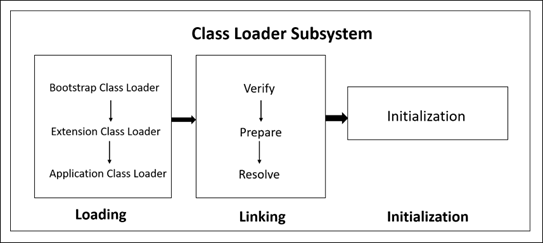Let's look at the JVM's
internal architecture. It includes a class loader, memory area, execution
engine, and other components.
Class
Loader Subsystem
Class loader is a JVM
subsystem that is used to load class files. The class loader loads the java
programm first when we run it. Java includes three built-in class loaders.
§ Loading
a) Bootstrap Class
Loader
The first-class loader
and the superclass of Extension Class Loader. It loads the rt.jar file, which
contains all Java Standard Edition class files such as java.lang package
classes, java.net package classes, java.util package classes, java.io package
classes, java.sql package classes, and so on.
b) Extension
Class Loader
This is the Bootstrap
class loader's child and the System class loader's parent. It loads the jar
files contained in the $JAVA HOME/jre/lib/ext directory.
c) Application
Class Loader
This
is the Extension classloader's child class loader. The classfiles are loaded
from the classpath. Classpath is set to the current directory by default. The
"-cp" or "-classpath" switches can be used to change the
classpath. Application classloader is another name for it.
§ Linking
a)
Verify
Verification ensures the correctness of the.class file, that is, whether it is properly formatted and generated by a valid compiler. If the verification fails, we get a java.lang run-time exception. VerifyError. The component ByteCodeVerifier performs this function. When this activity is finished, the class file is ready for compilation.
b)
Prepare
The JVM allocates memory for class variables and sets
it to default values.
c)
Resolve
Resolution
is the process of replacing type symbolic references with direct references. It
is accomplished by searching the method area for the referenced entity.
§ Initialization
All static variables are
assigned with their values defined in the code and static block during this
phase (if any). This is done in a class from top to bottom and from parent to
child in the class hierarchy.
Runtime
Data Areas
§ Method
Area: Method Area keeps per-class structures like the
runtime constant pool, field and method data, and method code.
§ Heap
Area: It is the runtime data area where objects are
assigned.
§ Stack
Area: Frames are stored in Java Stack. It stores local
variables and partial results, as well as participating in method invocation
and return. Each thread has its own JVM stack, which is created at the same
time as the thread. Each time a method is called, a new frame is created. When
a frame's method invocation is finished, it is destroyed.
§ PC
Registers: The address of the Java virtual machine instruction
currently being executed is stored in the PC (programme counter) register.
§ Native
Method Stacks: It contains all of the application's
native methods.
Execution
Engine
The Execution Engine will execute
the bytecode assigned to the Runtime Data Area. The Execution Engine reads and
executes the bytecode piece by piece.
§ Interpreter:
The interpreter
interprets bytecode more quickly but executes it slowly. The interpreter's
disadvantage is that when one method is called multiple times, a new
interpretation is required each time.
§ JIT
Compiler: The JIT Compiler
mitigates the interpreter's disadvantage. The Execution Engine will use the
interpreter to convert byte code, but when it encounters repeated code, it will
use the JIT compiler, which will compile the entire bytecode and convert it to
native code. This native code will be used directly for repeated method calls,
resulting in improved performance.
1. Intermediate Code Generator – This
programme generates intermediate code.
2. Code Optimizer – In charge of
optimising intermediate code.
§ Garbage
Collector: Gathers and
discards unreferenced objects. System.gc can be used to initiate garbage
collection (). The JVM's garbage collection collects the objects that are
created.




👏👏
ReplyDeleteVery systematic explanation!!!
ReplyDeleteGood info
ReplyDeleteCrisp and clear! Thank you for sharing!🙌
ReplyDelete🙌🙌
ReplyDeleteVery informative
ReplyDeleteNice Information
ReplyDelete